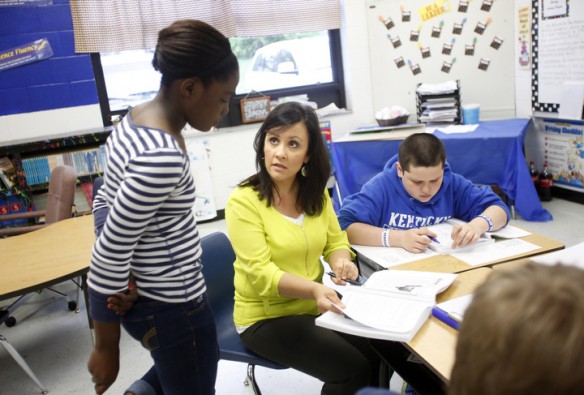
Fifth-grade teacher Revena Rich helps Jamiya Hamilton prepare for K-PREP testing at Tompkinsville Elementary School (Monroe County).
Photo by Amy Wallot, April 20, 2015
By Brenna R. Kelly
Brenna.kelly@education.ky.gov
Heather Geralds attended Tompkinsville Elementary School as a child, taught kindergarten there, became the school’s assistant principal then, this school year, she took the reigns as principal.
“This is kind of home to me,” she said. And Geralds wants her students to feel the same way.
“Our main thing is relationships with our students, making sure they know that we believe in them and that we have high expectations of them,” she said. “I think that’s one of the most important keys to our success.”
That success includes the Monroe County school being named a Blue Ribbon school by the U.S. Department of Education. Federal education officials declared the school an Exemplary High-Performing School based on student achievement and several other research-based indicators of school quality. Tompkinsville was one of four public schools in the state to receive the honor in 2014.
Just three years ago the school ranked in the 35th percentile of all Kentucky elementary schools and was classified as Needs Improvement. In the latest Unbridled Learning College and Career-Readiness for All accountability model, the school ranked in the 99th percentile, earning a Distinguished rating. Tompkinsville also met its annual measurable objective and student participation rate making it a School of Distinction.
The turnaround has come at a time when the school’s population of students who qualify for free- and reduced-price lunch has increased. This year about 89 percent of the school’s 400 students qualify, Geralds said.
“We don’t have a lot of resources here in T-ville,” she said, “A lot of the jobs have left the county, that’s kind of an obstacle for us. A lot of the factories aren’t here anymore so we don’t have the money that we used to have and we don’t have the money that the big cities have.”
But what they do have is an intense focus on teaching and learning and making sure the students know their teachers care about them.
“We celebrate a lot,” Geralds said. “We recognize students and we want to make sure that they know that we see what they are doing.”
After the Blue Ribbon award announcement, the school held surprise party in the gymnasium for the students then released blue balloons outside the school, she said.
For the last several years, the school has focused on using data to drive instruction, Geralds said. Teachers use formative and summative assessments in order to tailor instruction to meet each student’s needs.
Teachers use their Professional Learning Communities to analyze student data, coordinate units of study, create common assessments and build action plans for struggling students. Teachers also keep a folder with each student’s assessment results for each content area. The results are graphed over time so that teachers can review the results on a daily basis to check for mastery.
But teachers aren’t the only ones watching the data. Students have data notebooks in which they track their own learning and whether they are on track for proficiency.
“The students know where they are at, they keep up with it,” Geralds said. “It makes them more accountable.”
When students reach their goals, the school makes sure to celebrate the accomplishment with trips to the park, the swimming pool or Pizza Hut for lunch.
The school also celebrates student accomplishments in smaller ways with recognition at assemblies and in the classroom.
The teachers also celebrate their successes; more than half of the school’s teachers boarded a bus to go to Washington, D.C., to receive the school’s Blue Ribbon Award.
The award is just one of signs that the data-driven instruction which began under former Principal Kirk Biggerstaff is working, Geralds said.
“Why change something if it’s working,” said Geralds, who moved into the principal role after Biggerstaff became superintendent of Cumberland County.
Geralds also continued the schools’ participation in the Leader in Me program, which is based on the Seven Habits of Highly Effective People and is designed boost student’s self-confidence and instill real world skills.
Because of the program, students who might not normally want to speak in front of the class aren’t afraid to stand up in front of the entire school to lead the morning assembly. In fact, students take in the lead in most of the activities that go on in the school.
“We have students leading the board meetings here at school. Kindergarten graduation, 5th grade graduation, it’s all student led,” Geralds said.
Along with the program the school holds “Sharpen the Saw” days in which students get to choose an activity designed for relaxation and self-renewal. Each teacher hosts an activity in their room, such as a massage spa, nail salon, video games, math manipulatives or kick ball, and the students choose which one they want to attend.
Though it’s not all fun and games at Tompkinsville, teachers here do try to infuse their lessons with fun, hands- on activities so that often students might not even realize they are learning.
Teachers at Tompkinsville don’t use textbooks to teach, they create their own lessons from websites, other teachers or from scratch.
“Teachers here try to learn all about students’ interests and then go from there to plan our lessons,” said Karla Cloyd, a 4th grade math teacher who has taught at the school for 20 years. “I try to start the lesson with something hands on to actively engage and hook them and get them interested.”
Many teachers also use daily formative assessments that show them what each student needs to work on during a 50-minute intervention period each afternoon.
Students in kindergarten and first grade have a 50-minute literacy block in which they break into small groups based on reading level. Teachers and assistants then work with each group with the goal of moving the students to the next level.
At a weekly math lab students use hands-on activities to builds upon the content taught in the regular classroom. There’s also a similar weekly science lab.
“We want to prepare these students for middle school,” Geralds said, “and get them ready for college. We talk about the future a lot and we begin with the end in mind.”
The school has also worked hard to align the curriculum across all three of the district’s elementary schools because many students transfer often between the schools, Geralds said.
“We do have a high poverty rate here in our school and I think for what we have and as high as that rate is, we are doing some very good things,” she said. “Just because we have students who come from low- income families, that doesn’t mean they can’t learn.”
MORE INFO …
Heather Geralds heather.geralds@monroe.kyschools.us
Karla Cloyd karla.cloyd@monroe.kyschools.us




Leave A Comment